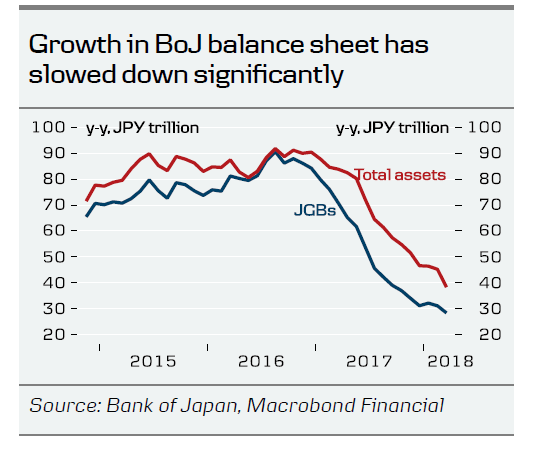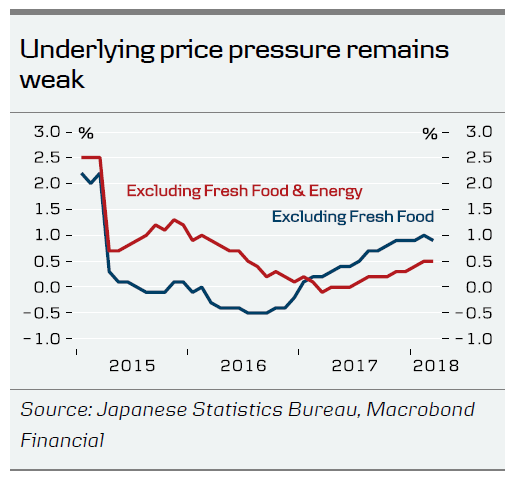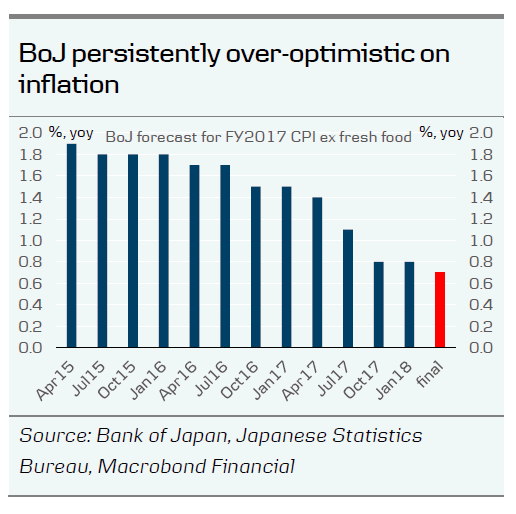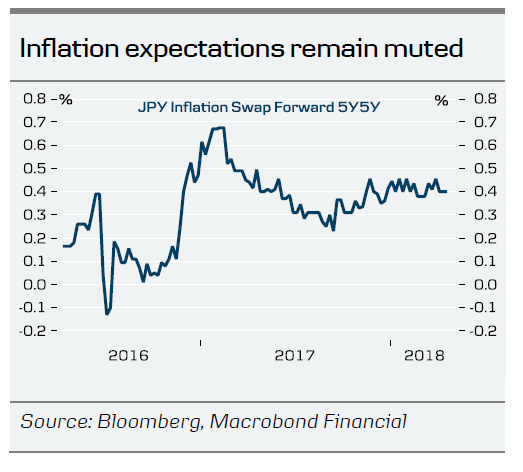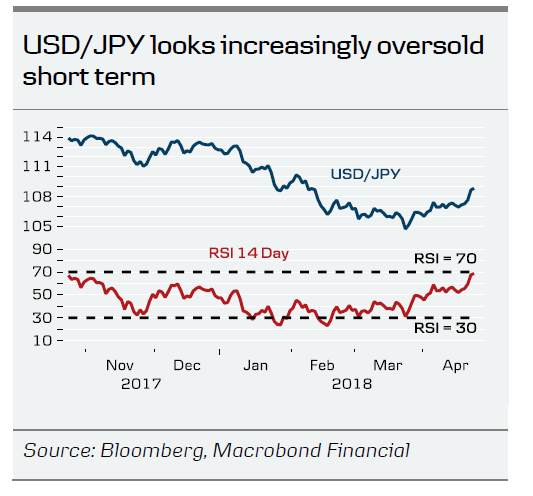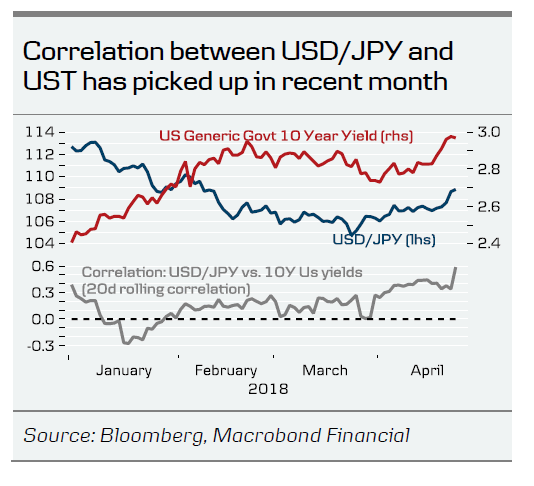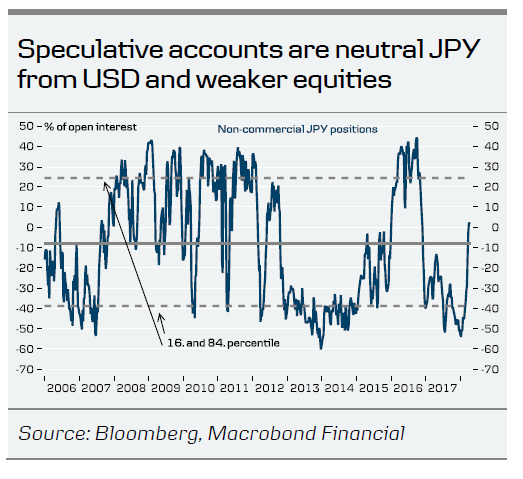- We expect the Bank of Japan to maintain its ‘QQE with yield curve control’ policy unchanged at the next monetary policy meeting ending on Friday 27 April.
- We do not expect new super dovish deputy Wakatabe to team up with Kataoka in the dissenting camp but instead pull board consensus slightly more dovish.
- Currently we consider the probability of further easing to be at least as high as the probability of tightening, but we do not see any changes to policies within a oneyear horizon.
- We expect USD/JPY to continue to trade mostly sideways within 105-110 in the near term, targeting 108 in 3M. In our view, it would require a substantial dovish shift in the Bank of Japan’s rhetoric for USD/JPY to settle above 110.
New deputy could pull board consensus more dovish
Since the beginning of the year, we have seen some change in the communications strategy from the Bank of Japan (BoJ). They used to refrain from answering questions related to future tightening, which left markets completely in the dark and caused some very jumpy reactions when Kuroda on occasions hinted at something related anyway. On 3 April, Kuroda said in parliament that internal discussions are at least taking place in the BoJ on the subject. He added that ‘open talk” of tapering or ending its stimulus would confuse markets.
Since the last meeting in March, the two deputies Iwata and Nakaso have been replaced by career central banker Masayoshi Amamiya and Professor Masazumi Wakatabe. Amaniya is likely to be located somewhere in the middle of the pack, when it comes to the board members’ policy stance – he did after all mastermind much of the policy measures himself, when he was head of both the bank’s monetary affairs group and markets division. Wakatabe, on the other hand, has been a vocal advocator of aggressive easing and he has previously expressed criticism of yield curve control, questioning whether it is enough to revamp inflation expectations. In December, he mentioned that options for further stimulus included raising the bond purchase guideline by JPY10trn a year, and even increasing the inflation target to three percent to lift up expectations. These comments align best with the one dissenter on the board, Goushi Kataoka, who has expressed a desire to reach the inflation target before the consumption tax hike in October next year and a possible economic downturn in the United States. We do not expect Wakatabe to actually join forces with Kataoka, but rather for board consensus to shift slightly more dovish. Kuroda has previously expressed a preference for unanimity among the governors.
The economy is losing momentum
Growth is primarily driven by foreign demand whereas private consumption is still looking weak. As growth in Japan’s most important export markets is becoming slightly more subdued and exporters now have to deal with a stronger JPY, we expect the economic upswing to lose some momentum. Q1 figures so far look fairly weak, and that is likely to be reflected in the BoJ’s quarterly macroeconomic outlook released alongside the statement on monetary policy. We thus expect some small downward revisions of the GDP forecast
We will also be getting a new inflation forecast from the BoJ. ‘According to sources familiar with the matter”, the FY2019 forecast will stay roughly unchanged – in January it stood at 1.8 percent. We still consider this very optimistic. Kuroda has also stated on several occasions that risks are skewed to the downside on the forecasts. The forecast for FY2018 from January at 1.4 percent is also very optimistic. The BoJ has been consistently overoptimistic on inflation for a number of years. Three years ago, it forecast inflation in FY2017 for the first time at 1.9 percent. Since then, the forecast has been revised down six times until the figure was final last Friday at 0.7 percent, still lower than the previous forecast. So far, it looks like wage increases have gone up somewhat with the spring wage negotiations but it is not likely to induce much of a pickup in inflation until inflation expectations pick up as well.
Currently we see the possibility of further easing from the BoJ as at least as likely as tightening. However, we do not see any policy changes within a one-year horizon and expect the BoJ to move steadily forward with the current policy framework. With the current pace at which the BoJ is picking up government bonds, policies are long lasting and we consider the potential gains from increasing the 10-year rate target to be largely outweighed by the risk of causing damage to the economic recovery.
USD/JPY range bound as the BoJ remains on autopilot
USD/JPY has gained substantially over the past month supported by general USD appreciation and not least rising yields in the US. While the break of 108 on 23 April most likely has widened the trading range to 105-110, it would, in our view, require a substantial dovish shift in the BoJ’s rhetoric on Friday (not our call) for USD/JPY to settle above 110. Short-term technical indicators, such as RSI, suggest that USD/JPY looks increasingly overbought and we expect USD/JPY to continue to trade mostly sideways in the near term targeting 108 in 3M.
The sell-off in the US fixed income market is likely to remain the key driver for the cross and while the flattening of the US yield curve remains a challenge for Japanese investors, as the rising FX hedge cost erodes the return in US FI assets, we think that the combination of a neutral speculative JPY positioning and higher US 10Y yields could be a supporting factor for USD/JPY near term (as long as US interest rates volatility does not increase). Longer term, we expect USD/JPY to gradually recover supported by continued solid global growth outlook and Fed-BoJ divergence and we expect the cross to eventually return to the 110-115 range in 6-12M. We target the cross at 110 in 6M and 112 in 12M.




